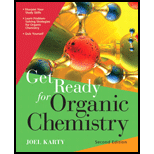
Concept explainers
Interpretation:
The McLafferty rearrangement for the molecular ion of pentanoic acid is to be drawn.
Concept introduction:
These two fragmentation pathways – heterolysis and α-cleavage – are also common to other compound classes that have
In addition to α-cleavage, there is another fragmentation pathway characteristic of carbonyl-containing compounds. A carbonyl-containing compound can undergo a McLafferty rearrangement if an alkyl group attached to the carbonyl carbon possesses a
Want to see the full answer?
Check out a sample textbook solution
Chapter G Solutions
Get Ready for Organic Chemistry
- looking at this reaction (first image), The second image shows the 13C NMR spectrum of the 2-acetnaphthone which is the starting material and an 13C NMR spectrum obtained for the reaction product: Based a comparison of the two 13C NMR spectra, is product A or product B the major product of the reaction? - Explain your reasoning.arrow_forwardExamine the 1H NMR spectrum of sesamin attached a. In the TABLE directly below the structure of sesamin shown here, assign 1H NMR peak ppm values to the equivalent sets of NON-AROMATIC hydrogensarrow_forwardHINT: Integration is just a ratio not the actual number of hydrogens. Q1: The following alcohol undergoes elimination in the presence of concentrated sulfuric acid, but the product shown is not its chief product. Instead, another isomeric six-carbon alkene forms. This product shows a large peak at 20.4 ppm and a smaller one at 123.4 ppm in its proton-decoupled 13C NMR spectrum. Draw the structure of the product and interpret the spectrum. Outline a mechanism for the formation of the product that possesses this spectrum. CH3 CH;-CH-CH-CH2-OH CH3 H,SO, CH;-CH-C=CH2 + H,0arrow_forward
- Consider the product below a) Predict the 1H NMR spectrum for this molecule. Predict the multiplicity, integration and relative ppm b) Predict the 13C NMR spectrum and DEPT spectra. Use (+) for positivesignals, (-) for negative signals, and (X) for no signal in the DEPT NMR spectra.arrow_forwardGive a clear explanation handwritten answer...complete the following reactionarrow_forwardExplain the transitions occurring when acetaldehyde (H-CHO) is exposed to EM radiation. Also explain the two Amax obtained in its UV spectrum by giving out the corresponding spectrumarrow_forward
- Please don't provide handwrittin solution...arrow_forward4. Look at the structure of the product (provided), 3 hydrogens are labelled (H₁, H₂ and H.). While H₂ may look simple on the ¹H NMR spectrum that you obtained (due to low resolution), it actually has a more complex splitting pattern. Create a tree diagram showing the splitting of H₁. Hint: H₁ is diastereotopic proton, assume JAB > Jac and assume no long range (>3 bond) coupling. AC Hb Ha I Hcarrow_forwardcan u explain both pleasearrow_forward
- 2) For each of the following pairs of compounds, name one absorption band that can be used to distinguish between them. State what the bond is (bond order, between which 2 atoms), and approximately where it appears in the IR spectrum (in cm ¹). b) HO 1-hexanol OH phenol H₂N 1-butanamine ethyl acetate cyclohexane OH hexanoic acid LOH cyclohexanol NH₂ butanamide diethyl ether cyclohexenearrow_forwardMass spectral analysis of 3,3-dimethyl-2-butanone results in several fragmentation pathways. Complete the mechanism, and draw the products for the fragmentation pathway that produces a mass spectrum peak at m/z 85. Include all nonbonding electrons and charges. a-cleavage a-cleavage products H3C, radical cationic CH3 intermediate H3C CH3 Add electrons and the charge for the resulting radical Draw the a-cleavage products based on the curved cationic intermediate, and add curved arrows for the arrows (one cation and one neutral radical) that are a-cleavage mechanism en route to mlz 85. consistent with a peak at m/z 85. Include all nonbonding electrons. Select Draw Rings More Erase Select Draw Rings More Erase / // H,C CH; H3C CH;arrow_forwardQ4. The following is the 13C NMR spectrum of a highly concentrated solution of dicyclopentadiene obtained in chloroform-d. Despite the high purity of the compound based on ¹H NMR, there is a massive peak observed at 77.2 ppm in this 13C spectrum, which doesn't correspond to any resonances expected for dicyclopentadiene. What is this peak, and why do you not see a corresponding peak for this compound in your ¹H NMR spectrum? 79-751 <-136.22 -132.62 132.27 132.23 135 130 125 120 115 110 105 100 95 90 85 80 75 70 65 60 55 50 45 40 35 30arrow_forward
 Organic Chemistry: A Guided InquiryChemistryISBN:9780618974122Author:Andrei StraumanisPublisher:Cengage Learning
Organic Chemistry: A Guided InquiryChemistryISBN:9780618974122Author:Andrei StraumanisPublisher:Cengage Learning
 Organic ChemistryChemistryISBN:9781305580350Author:William H. Brown, Brent L. Iverson, Eric Anslyn, Christopher S. FootePublisher:Cengage Learning
Organic ChemistryChemistryISBN:9781305580350Author:William H. Brown, Brent L. Iverson, Eric Anslyn, Christopher S. FootePublisher:Cengage Learning


